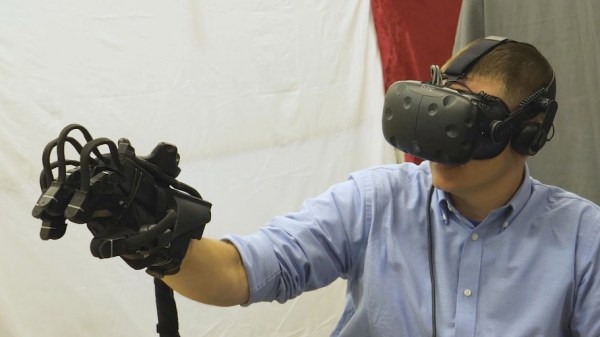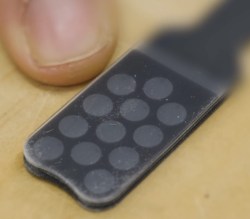A big challenge in the VR world is getting haptic feedback no matter where you are. That’s not so much of a problem when you’re sitting in a chair, the hardware can be attached to the chair or to something near you, what’s referred to as grounded force-feedback. But with VR, we’ve gotten used to at least moving around a room. How then do you feel the recoil of a gun, the pressure against a shield, the inertia of a sword slicing through the air, or the pulsations of magic sword emitting lightning?
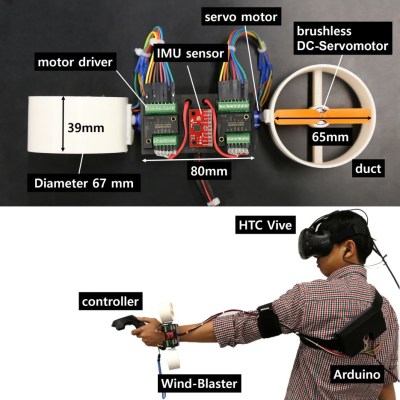 A team of researchers at the [MAKinteract Lab] at KAIST, a university in South Korea, have come up with a small device which straps to your wrist and provides all those types of feedback. It’s called the Wind-Blaster and consists of two ducted propellers which can provide up to 1.5N of force. Both propellers are mounted on servos, and with the help of an IMU, the propellers are oriented as needed. An Arduino doing PWM controls the motor speeds.
A team of researchers at the [MAKinteract Lab] at KAIST, a university in South Korea, have come up with a small device which straps to your wrist and provides all those types of feedback. It’s called the Wind-Blaster and consists of two ducted propellers which can provide up to 1.5N of force. Both propellers are mounted on servos, and with the help of an IMU, the propellers are oriented as needed. An Arduino doing PWM controls the motor speeds.
Fire a VR shotgun and the propellers quickly spin up to 33,000 RPM for just 250 ms, giving your lower arm a quick backward tug, providing the feel of a recoiling gun. Swing a VR sword through the air and the propellers rotate at 33,000 RPM for 400 ms and then linearly decelerate to a stop in 300 ms. Making the propellers move asynchronously with respect to each other causes rotation torque on your arm for a pulsating feeling for the magic lightning-emitting sword. A connected PC runs the games using the Unity game engine. As with drones, there is noise at around 41 dB but the user’s headphones block it out. Watch it in action in the videos below.
Here on Hackaday, we’ve covered few more ungrounded haptic feedback systems. There’s one which responds to light, another which lets you feel textures, and a glove which gets feedback as it controls a robotic gripper.
Continue reading “Wind-Blaster: Haptic Feedback That’ll Make You Recoil”


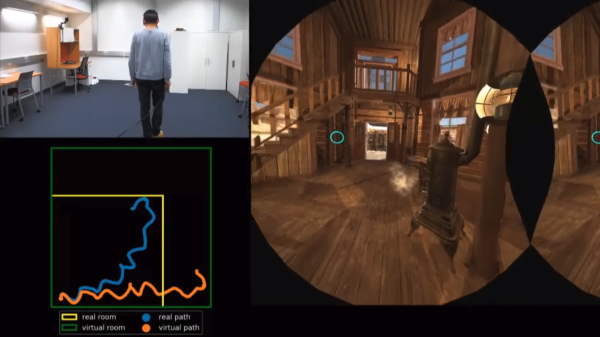


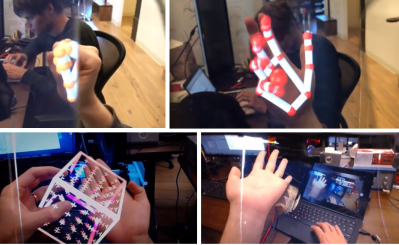 Now that we’ve got you excited, let’s mention what the North Star is not — it’s not a consumer device. Leap Motion’s idea here was to create a platform for developing Augmented Reality experiences — the user interface and interaction aspects. To that end, they built the best head-mounted display they could on a budget. The company started with standard 5.5″ cell phone displays, which made for an incredibly high resolution but low framerate (50 Hz) device. It was also large and completely unpractical.
Now that we’ve got you excited, let’s mention what the North Star is not — it’s not a consumer device. Leap Motion’s idea here was to create a platform for developing Augmented Reality experiences — the user interface and interaction aspects. To that end, they built the best head-mounted display they could on a budget. The company started with standard 5.5″ cell phone displays, which made for an incredibly high resolution but low framerate (50 Hz) device. It was also large and completely unpractical.
